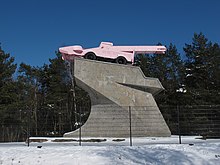Kleinmachnow tank memorial
Coordinates: 52 ° 24 ′ 43.1 ″ N , 13 ° 11 ′ 52.7 ″ E
In the summer of 1945 the Soviet military administration had a tank memorial erected in Berlin-Zehlendorf , which was later repositioned twice. As a result of the two plus four treaty , the Soviet army dismantled the tank on December 20, 1990. Since 1992 there has been a pink S-4M type snow loader on the base, a special vehicle technically based on the Soviet GAZ-51 truck . Sculptor Eckhardt Haisch is reminiscent of the Peaceful Revolution of 1989 . The Brandenburg State Office for Monument Preservation placed the armored base and art installation under protection. The designation "tank monument" has been preserved to this day.
First location from 1945
The tank memorial in Berlin-Zehlendorf commemorated the fallen of General Dmitri D. Leljuschenko's (1901–1987) tank army . The median of Potsdamer Chaussee was chosen as the construction site . It was part of the 1,392-kilometer connection between Aachen and Königsberg, which the National Socialists called " Reichsstrasse 1 ". The monument thus divided a symbol for the former territorial size of the German Empire . The Soviets placed a "Stalin tank" IS-2 on the newly built marble base . The monument at the level of the AVUS ( Dreilinden ) motorway was inaugurated on October 17, 1945.
During the Berlin blockade , the war memorial was the target of angry West Berliners who wrote anti-Soviet slogans on the pedestal and set the tank on fire. This sparked a political dispute between the Soviet Control Commission and the American city commander , who several times suggested relocating the monument to the GDR , which the Soviet representatives refused. For their part, the Americans categorically rejected the request of the Governing Mayor of Berlin, Ernst Reuter , that they should dismantle the monument themselves. The Americans then protected the memorial against further attacks with a sturdy wire cage.
As a reaction to the June Revolution, young people erect a mighty wooden cross directly in front of the tank cannon to commemorate the victims of the GDR people's uprising . The 17 June 1953 memorial has been preserved to this day.
Second location from 1954
Finally the Soviets decided to dismantle the tank. In 1954, Soviet pioneers began to erect a new pedestal on the territory of the GDR. A Soviet T-34 tank could already be seen there in October 1954 and the new monument was inaugurated on October 7, 1955. Ten names of fallen soldiers of the Red Army were listed on a metal plaque under the slogan “Eternal glory for the heroes who fell in the struggle for freedom and independence in our homeland”. A connection between the tank memorial and the names of the fallen soldiers, partly buried at the Soviet memorial in Berlin-Tiergarten , cannot be established. The SED cultivated the myth that the tank was the first to reach the Reich capital in 1945 .
Third location from 1969
With the construction of the GDR border crossing point in Drewitz , the monument was redesigned in 1969. The design of the base came from the High Command of the Soviet Armed Forces Group . Alfred Neumann , First Deputy Chairman of the Council of Ministers, provided the new ideological framework for the monument:
- "1. With the memory of the heroic struggle of the Soviet Army to liberate the German people from fascism, the monument is intended to document the strength and victory of socialism to express."
European parallels
The pink tank monument of Kleinmachnow is unique of its kind in Germany, but at the same time refers to Central Eastern European parallels since the early 1990s. For example, a pink Soviet tank was presented on Kinsky Square in Prague , and other post-Stalinist monuments were removed from public spaces or banned in sculpture parks.
swell
- Peter Boeger , Alexander Dowe : tank monument Berlin-Dreilinden. History and Background, Berlin 2014 ( ISBN 978-3-86331-167-4 ).
- Thomas Drachenberg : Conversion instead of conservation? The attempt to clarify whether the current monument preservation must have a guilty conscience in: Konversionen. Monument - Values - Change, annual conference of the Association of State Monument Preservators in the Federal Republic of Germany, Hamburg 2012, workbooks on monument preservation in Hamburg, No. 28, 2014 ( ISBN 978-3-922857-64-8 ), pp. 268-274.
- Permanent exhibition "Victory Sign - Symbol of the Cold War - Place of Remembrance" at the tank monument, Kleinmachnow 2014.
Web links
Individual evidence
- ^ "Inauguration of the monument in Zehlendorf", in: Neue Zeit, daily newspaper of the Christian Democratic Union, vol. 1, No. 77, October 19, 1945. - "Inauguration of the Russian monument", in: Der Tagesspiegel, October 17, 1945.
- ↑ "Panzerdenkmal should go to East Berlin", in: Der Tagesspiegel, No. 1761, June 28, 1951.
- ↑ Command of the Police, Event Reports (June 25, 1953), Berlin June 26, 1953, p. 2 (Police historical collection of the Berlin Police President).
- ^ "Soviet tanks are being dismantled", in: Berliner Morgenpost, May 3, 1955.
- ^ Minister for Transport (GDR): Submission to the Council of Ministers on the relocation and new construction of the Soviet tank memorial in Klein-Machnow, February 28, 1969 (Federal Archives, VA -07, files 8446, Vol. 3, pp. 126-130). - "Honor for tank soldiers" in: Neues Deutschland, October 6, 1969.


